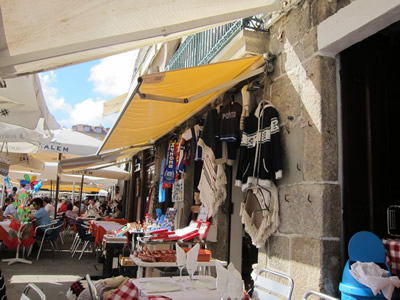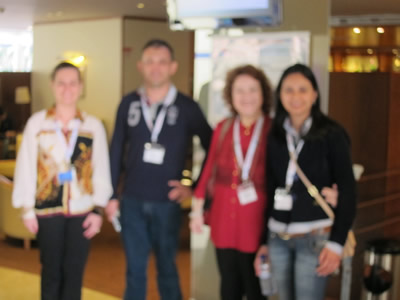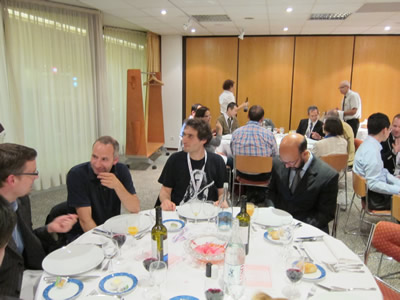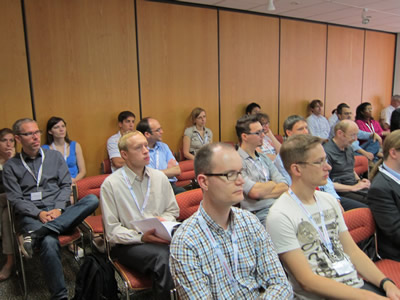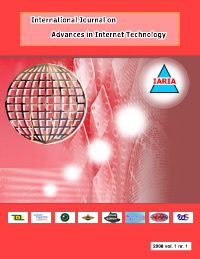ICIW 2022 - The Seventeenth International Conference on Internet and Web Applications and Services
June 26, 2022 - June 30, 2022
ICIW 2022: Call for Papers
Onsite and Online Options: In order to accommodate a large number of situations, we are offering the option for either physical presence or virtual participation (pdf slides or pre-recorded videos).
The International Conference on Internet and Web Applications and Services continues a series of co-located events that covers the complementary aspects related to designing and deploying of applications based on IP&Web techniques and mechanisms.
ICIW 2022 comprises five complementary tracks. They focus on Web technologies, design and development of Web-based applications, and interactions of these applications with other types of systems. Management aspects related to these applications and challenges on specialized domains are aided at too. Evaluation techniques and standard position on different aspects are part of the expected agenda.
Internet and Web-based technologies led to new frameworks, languages, mechanisms and protocols for Web applications design and development. Interaction between web-based applications and classical applications requires special interfaces and exposes various performance parameters.
Web Services and applications are supported by a myriad of platforms, technologies, and mechanisms for syntax (mostly XML-based) and semantics (Ontology, Semantic Web). Special Web Services based applications such as e-Commerce, e-Business, P2P, multimedia, and GRID enterprise-related, allow design flexibility and easy to develop new services. The challenges consist of service discovery, announcing, monitoring and management; on the other hand, trust, security, performance and scalability are desirable metrics under exploration when designing such applications.
Entertainment systems became one of the most business-oriented and challenging area of distributed real-time software applications’ and special devices’ industry. Developing entertainment systems and applications for a unique user or multiple users requires special platforms and network capabilities.
Particular traffic, QoS/SLA, reliability and high availability are some of the desired features of such systems. Real-time access raises problems of user identity, customized access, and navigation.
Particular services such interactive television, car/train/flight games, music and system distribution, and sport entertainment led to ubiquitous systems. These systems use mobile, wearable devices, and wireless technologies.
Interactive game applications require particular methodologies, frameworks, platforms, tools and languages. State-of-the-art games today can embody the most sophisticated technology and the most fully developed applications of programming capabilities available in the public domain.
The impact on millions of users via the proliferation of peer-to-peer (P2P) file sharing networks such as eDonkey, Kazaa and Gnutella was rapidly increasing and seriously influencing business models (online services, cost control) and user behavior (download profile). An important fraction of the Internet traffic belongs to P2P applications.
P2P applications run in the background of user’s PCs and enable individual users to act as downloaders, uploaders, file servers, etc. Designing and implementing P2P applications raise particular requirements. On the one hand, there are aspects of programming, data handling, and intensive computing applications; on the other hand, there are problems of special protocol features and networking, fault tolerance, quality of service, and application adaptability
Additionally, P2P systems require special attention from the security point of view. Trust, reputation, copyrights, and intellectual property are also relevant for P2P applications.
On-line communications frameworks and mechanisms allow distribute the workload, share business process, and handle complex partner profiles. This requires protocols supporting interactivity and real-time metrics.
Collaborative systems based on online communications support collaborative groups and are based on the theory and formalisms for group interactions. Group synergy in cooperative networks includes online gambling, gaming, and children groups, and at a larger scale, B2B and B2P cooperation.
Collaborative systems allow social networks to exist; within groups and between groups there are problems of privacy, identity, anonymity, trust, and confidentiality. Additionally, conflict, delegation, group selection, and communications costs in collaborative groups have to be monitored and managed.
Building online social networks requires mechanism on popularity context, persuasion, as well as technologies, techniques, and platforms to support all these paradigms.
During the last years, different web applications based on the use of Internet environments have been introduced to help teachers and students in the learning-teaching process. These web applications, mainly supported by Internet systems and services, are changing the traditional educational process not only in Higher Education (HE) qualifications, but also in open learning for any type of course. Nowadays, there exist different public and commercial Virtual Learning Environments (VLE) aimed at helping teachers to manage courses and contents, as well as to support the students’ learning process. In this sense, VLE are an important factor contributing towards the change from traditional educational methodologies to new paradigms including active teaching. This implies not only a shift in the way of tackling learning and teaching, but also new challenges for software engineers and developers. Virtual Learning Environments have to be built bearing in mind their mandatory use through the Internet, thus requiring important characteristics and capabilities such as security, good latency, several tools for interoperability, storage management, etc.
Also, the age of information and communication has revolutionized the way companies do business, especially in providing competitive and innovative services. Business processes not only integrates departments and subsidiaries of enterprises but also are extended across organizations and to interact with governments. On the other hand, wireless technologies and peer-to-peer networks enable ubiquitous access to services and information systems with scalability. This results in the removal of barriers of market expansion and new business opportunities as well as threats. In this new globalized and ubiquitous environment, it is of increasing importance to consider legal and social aspects in business activities and information systems that will provide some level of certainty. There is a broad spectrum of vertical domains where legal and social issues influence the design and development of information systems, such as web personalization and protection of users privacy in service provision, intellectual property rights protection when designing and implementing virtual works and multiplayer digital games, copyright protection in collaborative environments, automation of contracting and contract monitoring on the web, protection of privacy in location-based computing, etc.
We solicit both academic, research, and industrial contributions. We welcome technical papers presenting research and practical results, position papers addressing the pros and cons of specific proposals, such as those being discussed in the standard fora or in industry consortia, survey papers addressing the key problems and solutions on any of the above topics short papers on work in progress, and panel proposals.
Industrial presentations are not subject to the format and content constraints of regular submissions. We expect short and long presentations that express industrial position and status.
Tutorials on specific related topics and panels on challenging areas are encouraged.
The topics suggested by the conference can be discussed in term of concepts, state of the art, research, standards, implementations, running experiments, applications, and industrial case studies. Authors are invited to submit complete unpublished papers, which are not under review in any other conference or journal in the following, but not limited to, topic areas.
All topics and submission formats are open to both research and industry contributions.
ICIW 2022 conference tracks:
TRINT: Trends on Internet-based data, applications and services
Mapping social networks; Signed social networks; Interactive analysis; Personalized sentiment classification; Mobile devices and Internet technologies; Mobile IPv6 over Software Defined Network (SDN); Generative Mappings; Intensive mobile data processing; Virtualization of mobile networks; Personalized services in 5G networks; 5G+ HetHetNets; Information-centric satellite networks; Drone-based services; Internet of self-tunable sensing; Embedded Sensing; Context-aware and location-aware services; Interned-based vehicular networks; Geo-replicated data stores; Personal Cloud; Cloud interactive services; Energy harvesting and energy efficiency; Opportunistic spectrum access; High spectral efficiency communications; Interactive analysis on Big Data; Streaming/Real-Time/Active Streaming; Internet-scale real-time analytics; Real-time data aggregation; Big Data and Industrial 4.0 systems; Internet and Crowdsourcing; Mobile and wearable networks; Smart sensing networks; Internet-based healthcare services; Green Internet; Internet accessibility; Internet and Apps
TRWEB: Trends on Web-driven applications and services
Web3D. Harvesting Entities from the Web; Linking User Web Profiles; Web Crowd Rankings; Navigational Queries; focused Object Retrieval; Discovering Subsumption Relationships; Meshes on the Web; Interactive 3D Web Environments; Interactive 3D Graphics; WebGL, Optimized Javascript engines; Native 3D Web applications, Declarative 3D; WebGL Scene Creation; Web-Based Source Code Analysis; Web visualization of underground caves; Streaming compressed 3D data on the Web; Web3D User Interfaces; Linked Data on the Web; Web user-profiling; Mining large dense graphs/subgraphs; Web tables; Relationships in knowledge graphs; Microblog users; Web Tracking; Augmenting cross-domain knowledge bases; High-dimensional data; Visualizing large-scale; Consumer-oriented Web services
ML: Machine Learning for Web-based applications and Internet data
Machine learning models (supervised, unsupervised, reinforcement, constrained, etc.);
Generative modeling (Gaussian, HMM, GAN, Bayesian networks, autoencoders, etc.);
Explainable AI (feature importance, LIME, SHAP, FACT, etc.);
Bayesian learning models;
Prediction uncertainty (approximation learning, similarity);
Training of models (hyperparameter optimization, regularization, optimizers);
Active learning (partially labels datasets, faulty labels, semi-supervised);
Applications of machine learning (recommender systems, NLP, computer vision, etc.);
Data in machine learning (no data, small data, big data, graph data, time series, sparse data, etc.)
MOBWEB: Smart Mobile Web
Integrated mobile web ecosystems; Smart and intelligent mobile systems; Enterprise mobile apps; Mobile commerce and services; Mobil friendly web design; Responsive web design; Smart mobile solutions; Personalization of mobile web; Smart mobile apps experiences; Social media and smart mobile web; Mobile pervasive and ubiquitous applications; Mobile e-commerce statistics; Mobile hybrid applications; Web-to-Apps; Smart mobile pages; Smart mobile wallets; Web-enabled mobile devices; Web, Mobile, and IoT apps; Industrial applications and demos; Accessories and wearable technologies; Smart web testing
IWAS : Internet and Web-based Applications and Services
Web technologies, frameworks, languages, mechanisms; Web applications design and development; Interaction with/from Web-based applications; Web-based applications’ features; Management of Web-based applications; Evaluation of Web applications; Specialized Web applications; Aggregating multimedia documents; E-business, appliances, and services; IP Grid Management and Grid Services; IP-based convergent solutions and next generation networks; Standards, case studies and special groups on web-based applications; E-business system design, development, and management for SMEs
WSSA : Web Services-based Systems and Applications
Service Innovations; Service Architectures; Model-driven development of context-aware services; Context-aware service models, architectures and frameworks; Model-driven development of semantic Web services; Web services foundation, architectures, frameworks, languages; Web services architecture and business continuity; Special Web services mechanisms;
Semantic Web, Ontology, and Web services; Web service applications ; Data Management aspects in Web Services; Autonomic e-Business integration and collaboration; Web service based Grid computing and P2P computing; Web services based applications for e-Commerce; Multimedia applications using Web Services; Automatic computing for Web services; Web services challenges on trust, security, performance, scalability; Enterprise Web services; Web services discovery, announcing, monitoring and management; Platforms, technologies, mechanisms and case studies; Grid architectures, middleware and toolkits
ENSYS: Entertainment Systems
Developing entertainment systems and applications; Platforms for entertainment systems; Speech technology & its usability for entertainment systems; Networking requirements for entertainment systems; Traffic generated by entertainment applications; QoS/SLA on entertainment systems; Reliability and high availability of entertainment systems; Identify aspects in entertainment systems; Real-time access to entertainment systems; Customized access entertainment systems; Navigation and entertainment systems; Integration and interoperability aspects in entertainment systems; Entertainment systems and applications; Networking and system support for entertainment systems; Wireless and mobile technologies for entertainment; Wireless multimedia for entertainment; Systems for music and movie distribution; Games on mobile and resource-constrained devices; Mobile video entertainment systems; Car/flight/train entertainment systems; Ubiquitous entertainment systems; Interactive television; Technologies for sport and entertainment; WiFi wireless home entertainment systems; Wearable technologies for entertainment
P2PSA: P2P Systems and Applications
P2P architectures, techniques, paradigms; P2P programming and data handling; P2P security features; Data and compute intensive applications; P2P networks and protocols; P2P management; P2P Trust and reputation management; Fault tolerance in P2P, quality of availability, accounting in P2P; Self-adaptiveness in P2P overlay networks; Self-configurable P2P systems; Case studies, benchmarking; Copyright and intellectual property; Electronic marketplace, Digital asset management and trading systems; Platforms, environments, testbeds
ONLINE: Online Communications, Collaborative Systems, and Social Networks
Theory, frameworks, mechanisms, and tools for online communication; Methodologies and languages for on-line communications; Web services and XML use for online communications; Tools for assessing online work, distributed workload; Shared business processes; Collaborative groups and systems; Theory and formalisms of group interactions; Group synergy in cooperative networks; Online gambling, gaming, children groups; Identity features, risks, jurisdiction for online communications; Specifics emergency and e-coaching on online communications; B2B and B2E cooperation; Privacy, identify, security on online communications; Individual anonymity, group trust, and confidentiality on online groups; Conflict, delegation, group selection; Community costs in collaborative groups; Building online social networks with popularity contexts, persuasion, etc.; Technology support for collaborative systems; Techniques, mechanisms, and platforms for remote cooperation
SERCOMP: Service computing
Adaptive Architecture;
Business process integration and management;
Cloud Computing;
Collective Intelligence for Service Computing;
Computational Intelligence;
Data Mining of Actual Services;
Decision Science;
Digital EcoSystems Infrastructure;
Economic Clusters;
Economics and Economic Experiments;
Game Theory;
Human Modeling in Services;
Intelligent Agents and Multi-Agent Systems;
Intra- and Inter-enterprise services;
Knowledge Discovery for Service Computing;
Nature Inspired Computing Techniques for Service Computing;
Optimization of Service Processes;
Psychological Approaches to Services;
Self Organizing Infrastructure;
Sensing of Human Behaviors;
Service-centric business models and their economics;
Service discovery, repository and registry;
Service Engineering;
Service evaluation, measurements and delivery audit;
Service interaction, service ontologies and service composition;
Service Marketing;
Service-Oriented Architecture;
Service Oriented computing;
Soft Computing;
Society and business services (public, utility, business, healthcare, consulting, etc.);
Sustainable Frameworks;
Swarm Intelligence;
Ubiquitous and pervasive services (technology, context, security);
Value Creation in Services;
Web-based basics on service modeling, deployment and maintenance
SLAECE: Social and Legal Aspect of Internet Computing
Principles, theories, and challenges of legal and social aspects; Strategies, modeling, and requirements engineering of legal and social aspects;
Architectures, implementations, and deployment consideration of legal and social aspects;
Cyber threats, emerging risks, systemic concerns, and emergency preparedness;
Social computing and lifestyle computing;
Service marketing and customer relationship management;
Market structures and emerging business models;
Emerging legal issues due to new computing environment;
File / information sharing networks and user behavior;
Knowledge modeling, management, and application;
Negotiation and contracting as well as contract monitoring and enforcement;
E-democracy, e-policy, and governance;
Legal and social ontologies;
Privacy and copyright in collaborative environments and social networks;
Intellectual property rights;
Trust, security, and privacy;
Counterfeit forensic;
Identity management and access control;
Security and privacy in location-based services
VEWAeL: Virtual Environments and Web Applications for eLearning
E-Learning; Web Technologies and Tools for Educational Purposes; Services for E-Learning Platforms; Virtual Learning Environments (VLE); Course Management Systems; Web applications for Teaching; Social Implications of E-Learning; Lifelong E-learning; Teaching-Learning Experiences using the Internet for Educational Purposes; E-learning in the European Higher Education Area (EHEA) and other HE contexts; Web protocols for VLE; Security for VLE; QoS for VLE; Storage management in VLE
VIDEO INFO: Short video/links scientific content
Apps; Mobile social media; Video production; Innovative video content; Creative process; Dedicated apps; Special apps for short scientific reports; Techniques for a convincing summary report; Mobile and wearable devices for scietific reports; Combining open space and lab space in scientific reports; Handling inventories of short video scientific reports; Innovative mobile content; Online news; Volatile and just-in-time news; Report authenticity; Copyright and authorship; Ethical aspects; etc.
ECC: Enterprise cloud computing
Architectures for enterprise clouds;
Principles, concepts and methodologies of enterprise cloud computing;
Tools, technologies, methodologies and frameworks for enterprise cloud computing;
Enterprise IS architectures such as application, information and technology architectures;
Synergies between SOA, Grid Computing and Cloud Infrastructures;
Quality of Service (QoS) models;
'Elastic' and on-demand allocation and management of resources to meet business needs;
Benefits, issues and limitations of enterprise clouds;
Security, data integrity, legal and governance issues for enterprise clouds;
Management, monitoring an governance issues;
Portability of architectures, applications and data between cloud providers;
Reliability and maintenance of cloud-based business architectures;
Architectures for Software as a Service, Platform as a Service and Infrastructure as a Service;
Network architecture using Storage Clouds;
Experience reports with designing, building and using Cloud infrastructure;
Novel application architectures, best practices, case studies and surveys
Deadlines:
Submission | Mar 26, 2022 |
Notification | Apr 22, 2022 |
Registration | May 06, 2022 |
Camera ready | May 10, 2022 |
Deadlines differ for special tracks. Please consult the conference home page for special tracks Call for Papers (if any).
INSTRUCTION FOR THE AUTHORS
Authors of selected papers will be invited to submit extended versions to one of the IARIA Journals.
Publisher: XPS (Xpert Publishing Services)
Archived: ThinkMindTM Digital Library (free access)
Prints available at Curran Associates, Inc.
How to submit to appropriate indexes.
Only .pdf or .doc files will be accepted for paper submission. All received submissions will be acknowledged via an automated system.
Contribution types
- regular papers [in the proceedings, digital library]
- short papers (work in progress) [in the proceedings, digital library]
- ideas: two pages [in the proceedings, digital library]
- extended abstracts: two pages [in the proceedings, digital library]
- posters: two pages [in the proceedings, digital library]
- posters: slide only [slide-deck posted on www.iaria.org]
- presentations: slide only [slide-deck posted on www.iaria.org]
- demos: two pages [posted on www.iaria.org]
FORMATS
Only .pdf or .doc files will be accepted for paper submission. All received submissions will be acknowledged via an automated system.
Final author manuscripts will be 8.5" x 11", not exceeding 6 pages; max 4 extra pages allowed at additional cost.
Helpful information for paper formatting for MS Word can be found here.
There is a community provided LaTeX template: the CTAN package iaria (with full IARIA formatting rules, including IARIA citation style, but for providing citation style it is tightly bound to pdflatex+biblatex+biber). In addition, there is also iaria-lite (not bound to pdflatex+biblatex+biber, but compatible with any TeX stack; thus, it cannot provide the IARIA citation formattings, but only the titlepage and content-related IARIA formatting rules). Based on the iaria package, there is a minimal working example as Overleaf template. When you are using the LaTeX templates, please still adhere to the additional editorial rules.
Slides-based contributions can use the corporate/university format and style.
Your paper should also comply with the additional editorial rules.
Once you receive the notification of contribution acceptance, you will be provided by the publisher an online author kit with all the steps an author needs to follow to submit the final version. The author kits URL will be included in the letter of acceptance.
We would recommend that you should not use too many extra pages, even if you can afford the extra fees. No more than 2 contributions per event are recommended, as each contribution must be separately registered and paid for. At least one author of each accepted paper must register to ensure that the paper will be included in the conference proceedings and in the digital library, or posted on the www.iaria.org (for slide-based contributions).
CONTRIBUTION TYPE
Regular Papers (up to 6-10 page article -6 pages covered the by regular registration; max 4 extra pages allowed at additional cost- ) (oral presentation)
These contributions could be academic or industrial research, survey, white, implementation-oriented, architecture-oriented, white papers, etc. They will be included in the proceedings, posted in the free-access ThinkMind digital library and sent for indexing. Please submit the contributions following the instructions for the regular submissions using the "Submit a Paper" button and selecting the appropriate contribution type. 12-14 presentation slides are suggested.
Short papers (work in progress) (up to 4 pages long) (oral presentation)
Work-in-progress contributions are welcome. These contributions represent partial achievements of longer-term projects. They could be academic or industrial research, survey, white, implementation-oriented, architecture-oriented, white papers, etc. Please submit the contributions following the instructions for the regular submissions using the "Submit a Paper" button and selecting the contribution type as work in progress. Contributors must follow the conference deadlines, describing early research and novel skeleton ideas in the areas of the conference topics. The work will be published in the conference proceedings, posted in the free-access ThinkMind digital library and sent for indexing. For more details, see the Work in Progress explanation page. 12-14 presentation slides are suggested.
Ideas contributions (2 pages long) (oral presentation)
This category is dedicated to new ideas in their very early stage. Idea contributions are expression of yet to be developed approaches, with pros/cons, not yet consolidated. Ideas contributions are intended for a debate and audience feedback. Please submit the contributions following the instructions for the regular submissions using the "Submit a Paper" button and selecting the contribution type as Idea. Contributors must follow the conference deadlines, describing early research and novel skeleton ideas in the areas of the conference topics. The work will be published in the conference proceedings, posted in the free-access ThinkMind digital library and sent for indexing. For more details, see the Ideas explanation page. 12-14 presentation slides are suggested.
Extended abstracts (2 pages long) (oral presentation)
Extended abstracts summarize a long potential publication with noticeable results. It is intended for sharing yet to be written, or further on intended for a journal publication. Please submit the contributions following the instructions for the regular submissions using the "Submit a Paper" button and selecting the contribution type as Extended abstract. Contributors must follow the conference deadlines, describing early research and novel skeleton ideas in the areas of the conference topics. The work will be published in the conference proceedings, posted in the free-access ThinkMind digital library and sent for indexing. 12-14 presentation slides are suggested.
Posters (paper-based, two pages long) (oral presentation)
Posters are intended for ongoing research projects, concrete realizations, or industrial applications/projects presentations. The poster may be presented during sessions reserved for posters, or mixed with presentation of articles of similar topic. A two-page paper summarizes a presentation intended to be a POSTER. This allows an author to summarize a series of results and expose them via a big number of figures, graphics and tables. Please submit the contributions following the instructions for the regular submissions using the "Submit a Paper" button and selecting the contribution type as Poster Two Pages. Contributors must follow the conference deadlines, describing early research and novel skeleton ideas in the areas of the conference topics. The work will be published in the conference proceedings, posted in the free-access ThinkMind digital library and sent for indexing. 8-10 presentation slides are suggested. Also a big Poster is suitable, used for live discussions with the attendees, in addition to the oral presentation.
Posters (slide-based, only) (oral presentation)
Posters are intended for ongoing research projects, concrete realizations, or industrial applications/projects presentations. The poster may be presented during sessions reserved for posters, or mixed with presentation of articles of similar topic. The slides must have comprehensive comments. This type of contribution only requires a 8-10 slide-deck. Please submit the contributions following the instructions for the regular submissions using the "Submit a Paper" button and selecting the contribution type as Poster (slide-only). The slide-deck will be posted, post-event, on www.iaria.org.
8-10 presentation slides are suggested. Also a big Poster is suitable, used for live discussions with the attendees, additionally to the oral presentation.
Presentations (slide-based, only) (oral presentation)
These contributions represent technical marketing/industrial/business/positioning presentations. This type of contribution only requires a 12-14 slide-deck. Please submit the contributions following the submission instructions by using the "Submit a Paper" button and selecting the contribution type as Presentation (slide-only). The slide-deck will be posted, post-event, on www.iaria.org.
12-14 presentation slides are suggested.
Demos (two pages) [posted on www.iaria.org]
Demos represent special contributions where a tool, an implementation of an application, or a freshly implemented system is presented in its alfa/beta version. It might also be intended for thsoe new application to gather the attendee opinion. A two-page summary for a demo is intended to be. It would be scheduled in special time spots, to ensure a maximum attendance from the participants. Please submit the contributions following the submission instructions by using the "Submit a Paper" button and selecting the contribution type as Demos. The Demos paper will be posted, post-event, on www.iaria.org.
Tutorial proposals
Tutorials provide overviews of current high interest topics. Proposals should be for 2-3 hour long. Proposals must contain the title, the summary of the content, and the biography of the presenter(s). The tutorial slide decks will be posted on the IARIA site.
Please send your proposals to tutorial proposal
Panel proposals
The organizers encourage scientists and industry leaders to organize dedicated panels dealing with controversial and challenging topics and paradigms. Panel moderators are asked to identify their guests and manage that their appropriate talk supports timely reach our deadlines. Moderators must specifically submit an official proposal, indicating their background, panelist names, their affiliation, the topic of the panel, as well as short biographies. The panel slide deck will be posted on the IARIA site.
Please send your proposals to panel proposal
